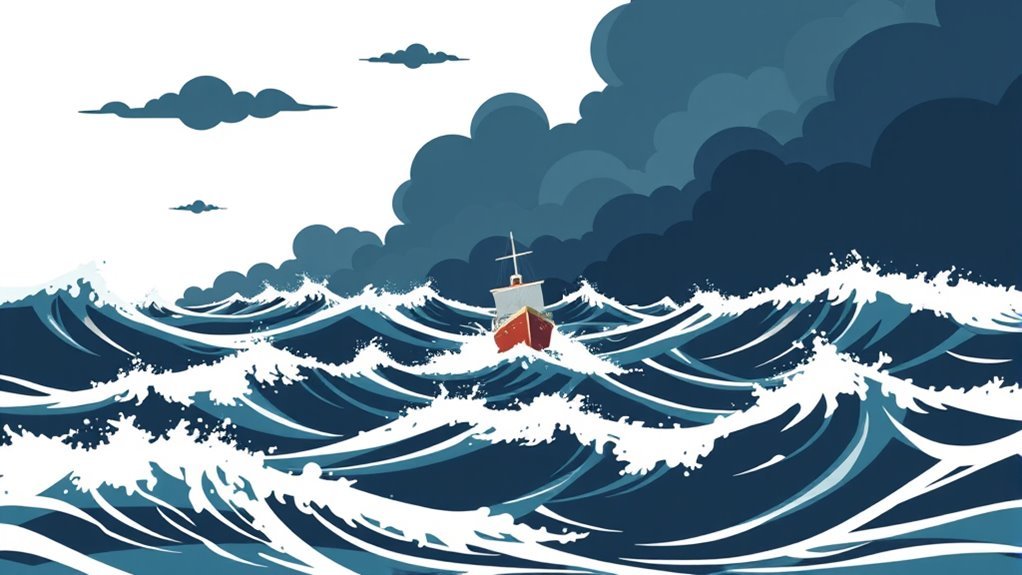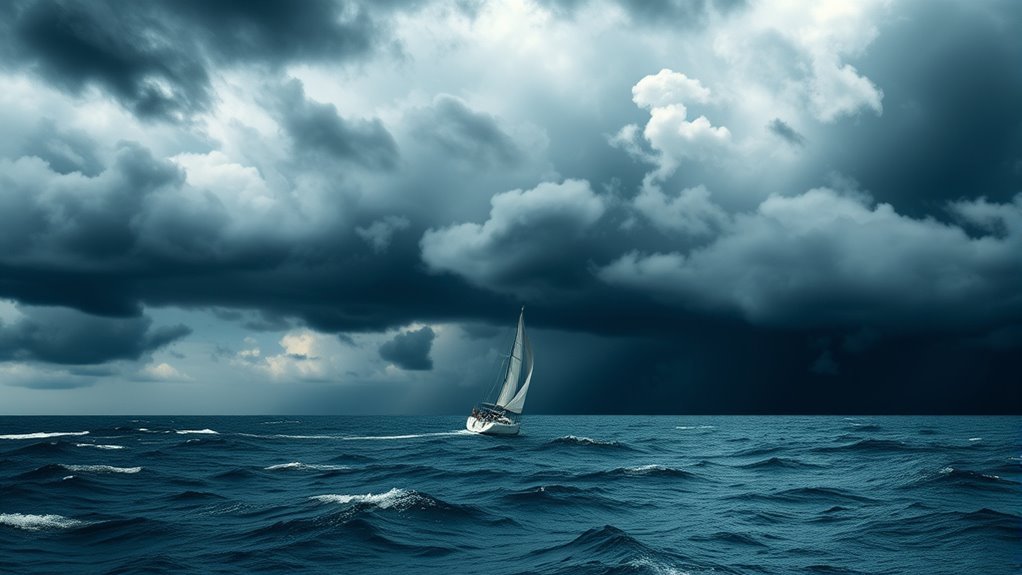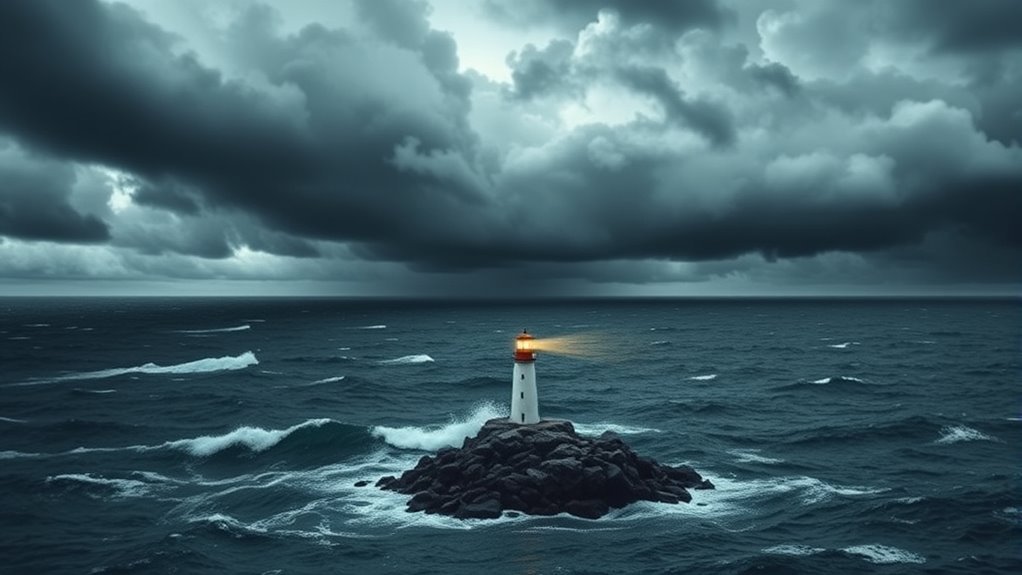Squalls are dangerous for ships due to their rapid onset, leading to sudden increases in wind speed and chaotic sea conditions. These weather phenomena can quickly destabilize vessels, impair visibility, and pose collision risks. Key indicators of an approaching squall include changes in cloud patterns, sudden temperature drops, and increased humidity. Being vigilant and monitoring these signs can improve safety. There are effective methods to detect squalls and recommended safety measures sailors can adopt to steer through them.
Main Points
- Squalls can cause sudden, sharp increases in wind speed, leading to loss of vessel control and potential capsizing.
- Reduced visibility during squalls increases the risk of collisions and accidents at sea.
- Signs of impending squalls include darkening skies, low-hanging clouds, and increased humidity, which sailors must monitor closely.
- Proper sail trimming and emergency preparedness are essential to maintain stability and respond effectively during squalls.
- Continuous vigilance and awareness of weather changes can prevent the dangers associated with unexpected squalls.
Understanding the Nature of Squalls
Squalls are sudden, sharp increases in wind speed often accompanied by rain, which can pose considerable challenges for maritime navigation. These meteorological phenomena typically develop rapidly and are defined by their short duration and intensity. They can arise from various weather systems, including thunderstorms, cold fronts, and sea breezes.
The shift from calm or moderate conditions to a squall can occur within minutes, often catching mariners off guard. Squalls can vary in intensity, with some causing only minor disturbances while others lead to hazardous conditions. The wind shifts associated with squalls can be unpredictable, complicating the decision-making process for sailors.
Understanding the nature of squalls involves recognizing the signs that precede their arrival, such as changes in cloud patterns, sudden drops in temperature, and increased humidity. Awareness of these indicators is essential for enhancing safety and ensuring effective navigation during unpredictable weather events.
The Impact of Squalls on Vessels

Squalls can pose considerable challenges for vessels at sea, particularly due to sudden changes in wind patterns.
These unpredictable gusts can lead to a rapid loss of control, affecting navigation and stability.
Additionally, reduced visibility during squalls increases the risk of collisions and accidents, necessitating heightened caution from mariners.
Sudden Wind Changes
When sudden wind changes occur, the impact on vessels can be both immediate and substantial. These abrupt shifts can lead to a rapid increase in wind speed and direction, causing vessels to heel unexpectedly.
This instability can threaten the safety of crew and cargo, as well as the vessel's structural integrity. A sudden gust may also impair a captain's ability to maneuver effectively, increasing the risk of collisions or grounding.
Additionally, vessels may experience difficulties in maintaining course, leading to heightened anxiety among the crew. The unpredictable nature of squalls makes it essential for ship operators to remain vigilant and prepared for these wind shifts, ensuring that appropriate safety measures are in place to mitigate potential hazards.
Reduced Visibility Risks
How do sudden weather changes affect visibility at sea?
Squalls often bring intense rain, fog, and shifting winds, drastically diminishing visibility for vessels. This abrupt reduction can create hazardous conditions, making it difficult for mariners to steer safely.
Ships may struggle to detect nearby vessels, navigational aids, or landmasses, increasing the risk of collisions. Additionally, the sudden onset of precipitation can obscure radar and sonar systems, further complicating situational awareness.
As squalls can develop rapidly, crews must be prepared to respond quickly, often relying on instinct and experience rather than technology. The unpredictable nature of squalls highlights the importance of vigilance and early detection, as reduced visibility can lead to catastrophic outcomes if not properly managed.
Recognizing the Warning Signs of Squalls
What signs might a sailor look for to anticipate an approaching squall?
Experienced sailors often observe changes in wind patterns, noting sudden shifts in direction and an increase in wind speed, which can signal an impending squall.
Darkening skies, particularly the appearance of ominous, low-hanging clouds, serve as a visual cue that conditions are deteriorating.
Additionally, a noticeable drop in temperature can accompany these atmospheric changes, indicating instability.
Sailors may also witness a buildup of humidity, with the air feeling heavier, which often precedes a squall.
The presence of birds suddenly taking flight or seeking shelter can further indicate that turbulent weather is on the horizon.
Observing these signs allows sailors to make timely decisions to secure their vessels, adjust sails, or seek safer waters, potentially mitigating the dangers associated with sudden squalls.
The Role of Weather Patterns in Squall Formation

Understanding the dynamics of weather patterns is essential for comprehending squall formation. These sudden, intense storms often arise from specific meteorological conditions, primarily linked to the interaction of air masses. Warm, moist air can rapidly ascend, displacing cooler, denser air, leading to turbulent weather.
Key factors influencing squall development include:
- Cold fronts: The abrupt boundary where a cold air mass displaces warm air, triggering strong winds.
- Thermal instability: Increased surface heating can create rising air pockets, contributing to storm intensity.
- Sea surface temperature: Warmer waters fuel evaporation, enhancing storm strength.
- Topographical influences: Mountains or coastal features can disrupt airflow, intensifying squall conditions.
Understanding these elements is vital for anticipating the sudden onset of squalls, which can pose considerable threats to maritime activities.
Effective Techniques for Squall Detection

Although squalls can develop rapidly, effective detection techniques play an essential role in ensuring maritime safety. Various methods are available to help sailors identify the early signs of impending squalls.
One vital approach is the use of radar systems, which can detect precipitation and wind shifts associated with squall lines. Additionally, satellite imagery provides broader atmospheric data, highlighting areas of potential instability.
Meteorological buoys equipped with sensors can monitor real-time weather conditions, offering important information on wind speed and direction changes. Visual cues, such as darkening skies, sudden temperature drops, or shifts in wind patterns, should also alert crew members to possible squalls.
Finally, investing in advanced weather forecasting technology and maintaining constant communication with local meteorological services can greatly improve squall detection capabilities. By employing these techniques, maritime operators can better anticipate squalls and take appropriate action to safeguard their vessels and crew.
Safety Precautions for Sailors Facing Squalls
Sailors must adopt specific safety precautions when facing squalls to guarantee their well-being and the integrity of their vessel.
Proper sail trim techniques can greatly mitigate the impact of sudden wind changes, while an emergency preparedness checklist equips crews to respond effectively in crisis situations.
Understanding these measures is essential for maneuvering the unpredictable nature of squalls.
Proper Sail Trim Techniques
Facing the sudden onset of a squall demands immediate and precise sail trim adjustments to guarantee safety and maintain control. Sailors must act swiftly to reduce sail area, ensuring stability and preventing capsizing.
Proper techniques include:
- Easing the mainsail to minimize heeling and allow the boat to right itself.
- Shortening the headsail to decrease the vessel's windage and improve maneuverability.
- Trimming the sheet to balance power and maintain speed while reducing excessive force on the rigging.
- Monitoring wind shifts to modify the sail trim continually, keeping the boat responsive.
Emergency Preparedness Checklist
When preparing for the unpredictable nature of squalls, an all-encompassing emergency preparedness checklist becomes essential for ensuring safety at sea.
Sailors should first verify that all safety gear, such as life jackets, flares, and first aid kits, is readily accessible and in good condition. It is important to secure all loose items on deck to prevent them from becoming projectiles.
Next, the crew must conduct a thorough briefing, clarifying roles and responsibilities during a squall. Ensuring that communication tools are functioning properly is essential for coordinating responses.
Additionally, sailors should review anchoring procedures and have a plan for reefing sails quickly.
Finally, maintaining a vigilant watch for weather changes can provide important early warnings to mitigate risks associated with squalls.
Case Studies: Real-Life Squall Encounters
Sudden and fierce, squalls have caught many vessels off guard throughout maritime history.
These abrupt weather events can transform calm seas into chaotic turmoil in mere moments. Notable incidents illustrate their potential dangers, showcasing the unpredictability of nature.
- A cargo ship, sailing smoothly, suddenly faced 60-knot winds that flipped containers overboard.
- A recreational yacht, enjoying a sunny day, found itself engulfed in a wall of rain and gusts, leading to a frantic struggle to regain control.
- A fishing vessel, caught unaware, experienced a rapid drop in visibility, resulting in a near collision with another boat.
- A cruise liner, once leisurely gliding across tranquil waters, was forced to alter its course dramatically as waves surged and passengers braced for impact.
These cases highlight the importance of vigilance and preparedness when maneuvering through areas prone to squalls, underscoring the ever-present risks at sea.
Common Questions
Can Squalls Occur in Any Season or Region?
Squalls can indeed occur in any season or region, typically forming in response to various atmospheric conditions. Their unpredictability makes them a concern for meteorologists and those steering through waters prone to sudden weather changes.
What Are the Signs of an Impending Squall?
The signs of an impending squall include darkening skies, rapidly changing wind direction, sudden temperature drops, and increased humidity. These indicators often precede intense rain, strong gusts, and turbulent conditions, signaling potential danger for nearby vessels.
How Fast Can Squalls Develop and Pass?
Squalls can develop rapidly, often within minutes, and may last from a few minutes to half an hour. Their swift changes in wind speed and direction pose considerable challenges for navigation and safety at sea.
Are Squalls More Dangerous at Night?
Squalls can pose increased dangers at night due to reduced visibility and the difficulty of detecting changes in weather. Sailors may struggle to respond promptly, heightening the risks associated with sudden and severe conditions.
What Technology Helps in Squall Forecasting?
Advanced technologies such as Doppler radar, satellite imagery, and weather models aid in squall forecasting. These tools provide critical data on wind patterns and precipitation, allowing for timely warnings and improved safety for vessels traversing affected areas.

